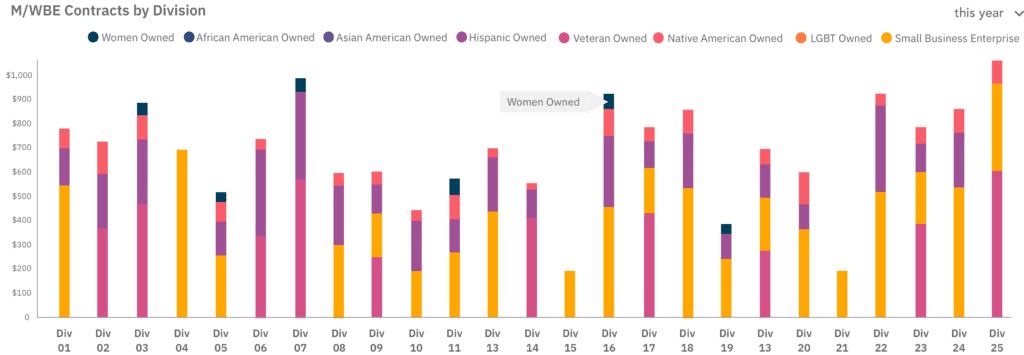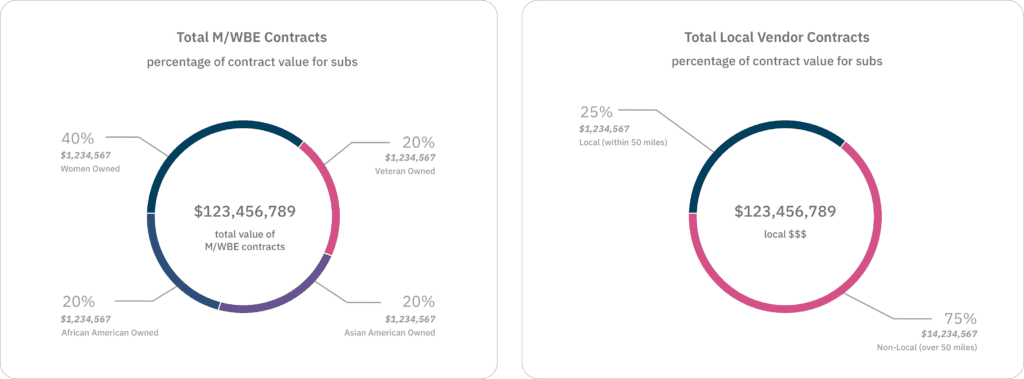
by Lauren Richardson
Sustainability Manager at Green Badger
Social metrics in construction are not new. In fact, many are required on publicly funded projects. But the growing importance of ESG in construction means learning how to translate those metrics on every project, not just the few that require it.
So what should construction owners and sustainability professionals be looking at when it comes to social metrics tracking for construction? Let’s break it down.
Minority/Women/Veteran Owned Business Enterprises (MWBE)
Perhaps the most common metric to track is MWBE participation, which means providing meaningful participation to MWBE’s as subcontractors or suppliers in the performance of your construction projects. This is often measured as a goal based on contractual dollar value of MWBE owned companies compared to the overall contract value.
For example, if a project has a 20% MWBE goal and a total contract value of $10 million, then at least $2 million would need to be awarded to subcontractors or supplies that are owned by MWBE.
There are other entities, such as Small Business Entities and Local Business entities, that also see performance goals established. Business can count across multiple classifications as well – a small, local, women-owned business would contribute to all three project goals.
Local Participation
Local participation varies in how your organization standardizes ESG and your team will need to determine what is appropriate for them in the markets they work in. Whether a goal is set by radius (within 25 miles of the project), region (Coastal Georgia), or zip code, organizations will need to determine their own measure of success.
Project Philanthropy
A final metric that some project teams are benchmarking is project philanthropy – have a goal of either financial contributions or volunteer hour participation from a project team and their subcontractors. This is highly company specific – there’s not an industry benchmark to establish, and can vary greatly depending on market, project size and project duration.

Supplier Diversity
Supplier Diversity is a strategic program designed to encourage using minority-owned, women owned, veteran owned, LGBT-owned, service disabled veteran owned, and small businesses such as suppliers.
Benefits to the Sponsoring Company working with a broad range of diverse SUPPLIERS:
- larger market share
- sustain and transform the supply chain
- meet compliance requirements
- formalize strategic frameworks surrounding diversity initiatives
- better brand loyalty and perception—which impact a company’s bottom line
- community engagement
Diverse supply bases:
A diverse supply base encourages innovation and increases competition between suppliers, ensuring that contractors receive the best value at the best possible price
They also:
- offer resiliency and continuity
- help avoid shortages during economic downturns
- tend to move faster
- can be more innovative
- can help companies reach previously untapped markets
- better reflect the diversity of global consumers
BENEFITS TO THE SUPPLIERS:
- allow underrepresented populations to compete and thrive in business
- contribute to improved social and economic outcomes

BEST PRACTICES FOR CREATING SUPPLIER DIVERSITY
Clear and Actionable Goals
- What are your reasons for creating a supplier diversity program?
- What are your goals for the bottom line?
- What are goals of management, procurement, and other stakeholders?
- How do goals supplier diversity goals align with your company’s core values?
Measurement and Reporting: Performance Indicators used to measure supplier diversity initiatives
Diverse Spend: How much money your company is spending/saving with diverse suppliers
Onboarded /Diverse Count: The number of new diverse suppliers onboarded
Community/Economic Impact: How doing business impacts the local economy where your suppliers are located and do business: Jobs created; Tax revenue generated
Cost vs Savings: spending vs revenue over time
Revenue Impact: revenue earned/ projected
Market:
- Market share/growth
- Company brand
- Deals Won
- For a given time frame, how many diverse suppliers were onboarded, how many left
- Deals Lost (Due to Disqualified Suppliers): If you’re losing deals because suppliers don’t meet your qualification criteria
- Incentives from the federal and state governments that come from using Tier 2 and 3 suppliers*
Tier 1 – Partners with whom you directly conduct business
Tier 2 – Where your tier 1 suppliers get materials
Tier 3 – Raw materials
Set a Baseline
Look through your list of current suppliers and record baseline figures for each metric that you’ve chosen to track.
Payroll and procurement departments can help you access data on information like:
- How much your company is spending with each supplier
- How long you have worked with each supplier
- Volume supplied
- Diversity status
This is often measured as a goal based on contractual dollar value of MWBE owned companies compared to the overall contract value. For example, if a project has a 20% MWBE goal and a total contract value of $10 million, then at least $2 million would need to be awarded to subcontractors or supplies that are owned by MWBE.
If your company has collected diversity certification data before, you can collect it manually or through a tool like CVM’s proprietary Supplier Locator tool, which allows you to search for suppliers in more than 40 categories and invite them to bid on opportunities.

Green Badger’s Construction ESG platform will soon allow for construction MWBE tracking in addition to live carbon, energy, waste, water and esc tracking capabilities that are already live. This graph shows MWBE spend by division number.
Collect Data
You can collect and analyze data by hand, but doing so will require more time and resources as your program continues to scale. Supplier diversity tracking software helps you automate this process and makes it easier to draw the insight you need to optimize your organizational spending, improve your diverse contracting efforts, and hone the impact of your program.
Evaluate your Diversity Program: Based on the data, where is your program successful and how can it be improved? Report, review, and adjust your program to yield competitive advantages for your company and your partners throughout your inclusive supply chain.
Elements of Success:
- Executive level support
- Culture of accepting change
- Database of diverse suppliers
- Resources and commitment to find, develop, promote and sustain diverse supplier relationships
- Willingness to displace incumbent, non-diverse suppliers
- Metrics and accountability to increase diversity supplier spend
- Ability to perform to expected terms and conditions
Onboarding: Small suppliers may need training, mentoring, and help with risk assessment. They may need help working with a very large organization.
Visibility: Give diverse suppliers adequate notice to compete for upcoming bidding opportunities.

Green Badger’s Construction ESG Platform
Green Badger has officially launched a construction ESG benchmarking platform for companies to use in their sustainability and diversity efforts.
The Construction ESG platform built specifically for construction and development activities.
As a general contractor or developer, if you haven’t been asked for ESG metrics yet, you will. From voluntary initiatives like the Contractor’s Commitment to proposed regulatory carbon disclosures to the growing number of sustainable impact investors with their own net-zero carbon goals, the demands to pursue ESG data and benchmarking is driving challenges and opportunities across an organization.
Companies are still learning how to track and report ESG metrics across their construction portfolio and how to measure ESG impact. Whether a goal is set by radius (within 25 miles of the project), region (Coastal Georgia), or zip code, organizations will need to determine their own measure of success, what is appropriate for them in the markets they work in.
Environmental metrics can include:
- energy consumption
- carbon emissions
- water use
- waste generation and diversion
Social metrics can include:
- minority and women own business enterprise inclusion
- provide meaningful participation to MWBEs as subcontractors or suppliers in the performance of this construction project
- local participation
- varies in definition and organizations standardizing
- project-based philanthropy.
- have a goal of either financial contributions or volunteer hour participation from a project team and their subcontractors.
- varies greatly depending on market, project size and project duration

Green Badger’s Construction ESG platform will soon allow for construction MWBE tracking in addition to live carbon, energy, waste, water and esc tracking capabilities that are already live. These graphs shows MWBE contracts by percentage of contract value for subcontractors and total local vendor contracts by percentage of contract value for subcontractors.
Social Responsibility (CSR) Reporting
Social metrics in construction are not new. In fact, many are required on publicly funded projects. The growing importance of ESG is translating those metrics on every project, not just the few that require it.
Governance metrics tend to originate at the corporate level still being evaluated how it may relate on a project-by-project basis.
Green Badger’s platform allows teams to track jobsite energy, carbon, waste and water – (generated by the contractor as well as subcontractors, along with product transport).
Measure, Analyze, and Set Goals
The platform shows the impact of construction activities. Teams can benchmark each project across corporate goals, analyze performance, and use the data to set reduction goals.
Additionally, you can visualize your data with our corporate dashboards to measure project team performance and it is very useful for corporate ESG (Environmental Social Governance) reporting. You can also see an overview video here.
Where to find Certified Diverse Suppliers
Supplier databases such as that offered by Thomasnet can be filtered by diversity type, such as women-owned, African American, veteran owned, etc. You can also visit the Minority Business Development Agency’s website or contact the local Small Business Administration in your area.
Federal Certification Codes:
- SDB Small Disadvantaged Business
- WOSB Woman-Owned Small Business
- HUB Zone Historically Underutilized Business
- HBCU/MI Historically Black Colleges & Universities and Minority Institutions
- VOSB Veteran-Owned Small Business
- SDVOSB Service-Disabled Veteran-Owned Small Business
- ANC Alaska Native Corporations (ANCs) and Indian Tribes that have not been certified by SBA as Small Disadvantaged Businesses
- ANC Alaska Native Corporations (ANCs) and Indian Tribes that are not small businesses

More Resources on MWBE and Supplier Diversity:
- What is Supplier Diversity? – Supply Chain Game Changer
- Expanding our commitments to supplier diversity
- What Should Be My Supplier Diversity Metrics For 2021? – Hire Ground
- The 2019 State of Supplier Diversity – Diverse Suppliers-v5 (cvmsolutions.com)
- Supplier Diversity Program | 5 Key Components – Una
- Supplier Diversity Tracking, Metrics and Reporting
- MWBE Certification: What it Means for Your Organization and Why it Matters (nextcity.org)
Learn how Green Badger’s construction ESG software can automate project and corporate reporting requirements.






